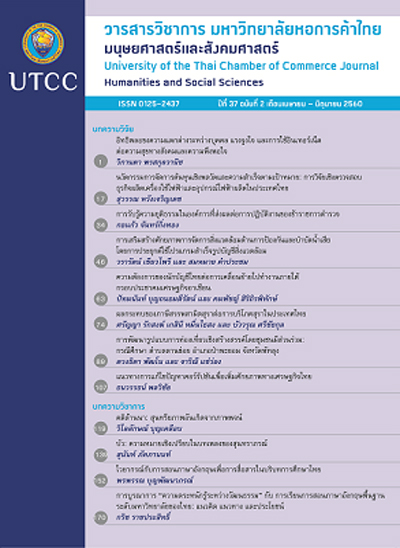Creative Economy Strategies Affecting Business Organization Success: A Case Study of Industrial Entrepreneurs in Nakhon Pathom Province
Main Article Content
Abstract
The objectives of this research is to examine the creative economy strategies, which are used in business organizations: Product Differentiation, Business Alliance, Eco-friendly Production, Innovation, Human Resources, and Marketing that significantly affect to the success of industrial enterprises in Nakhon Pathom. The success of industrial enterprises refers to revenue, profit, stability customer satisfaction toward company’s product, and the number of customer in current year. The study was conducted by using the questionnaire as a tool to collect data from the 400 top management or entrepreneurs in industrial business. The statistics used to test the hypothesis in the research were descriptive statistic and multiple linear regression. Consequently, creative economy in each aspect significantly affects business success: Marketing (bCS6 = 0.521), followed by product differentiation (bCS1 = 0.437) and innovation (bCS4 = 0.389) at 0.01 significant level, 67.5 variance.
Article Details
ลิขสิทธิ์ของบทความ
ผลงานที่ได้รับการตีพิมพ์ถือเป็นลิขสิทธิ์ของมหาวิทยาลัยหอการค้าไทย ห้ามมิให้นำเนื้อหา ทัศนะ หรือข้อคิดเห็นใด ๆ ของผลงานไปทำซ้ำ ดัดแปลง หรือเผยแพร่ ไม่ว่าทั้งหมดหรือบางส่วนโดยไม่ได้รับอนุญาตเป็นลายลักษณ์อักษรจากมหาวิทยาลัยหอการค้าไทยก่อน
References
Budsankom, P. (2011). Selection process for multiple regression. Journal of Educational Measurement Mahasarakham University, 17(1), 43-60. (in Thai).
Chamchan, C., & Boonyamanond, S. (2013). Roles of creative economy for community and social development in Thailand. NIDA Economic Review Journal, 7(1), 109-151. (in Thai).
Donkwa, K. (2016). A model of factors in creative economics and innovative behavior affecting the long-run AEC strategies of Thailand. Nakhon Ratchasima, Thailand: Suranaree University of Technology. (in Thai).
Erwan, P. (2017). Indicators of business success for entrepreneurs. Retrieved March 20, 2017, from https://www.bangkokbiznews.com/recommended/detail/424 (in Thai).
Finklestien, R. (2006). What successful businesses have in common. Retrieved August 15, 2016, from https://www.entrepreneur.com/article/83764
Foley, P., & Green, H. (1989). What is success: Small business success. Lodon, England: Chapman.
International Institute for Trade and Development. (2011). Creative economy and development issues in Thailand. Bangkok, Thailand: Chulalongkorn University. (in Thai).
Jonpradit, S. (2013). The influence of applying creative economy concept, factors driving creative economy and characteristics of entrepreneurs to market success factors of five-stars One Tambon One Product (OTOP) in Thailand (Unpublished doctoral dissertation). Dhurakij Pundit University, Bangkok, Thailand. (in Thai).
Kaewphanngam, C., & Tharmmapornphilas, R. (2013). Education policy and human resource development in Thailand under creative economy. NIDA Economic Review Journal, 7(1), 251-306. (in Thai).
Kanthachai, N. (2015). Quality management and market orientation affecting the organizational performance of SMEs in Thailand. University of the Chamber of Commerce Journal, 35(4), 42-53. (in Thai).
Lekmat, L., & Hongratanawong, L. (2017). Value creation in pineapple industry. University of the Thai Chamber of Commerce Journal, 37(1). 79-90. (in Thai).
Office of Industrial in Nakhon Pathom Province. (2015). Investment report in Nakhon Pathom Province 2015. Nakhon Pathom, Thailand: Author. (in Thai).
Porter, M. E. (1990). Competitive strategy: Techniques for analyzing industries and competitors. New York: Free Press.
Sirikudta, S. (2013). Creative economy strategies affecting business organization success: Case study of upper central part industrial entrepreneurs. Kasetsart Journal (Social), 34(3), 428-439. (in Thai).


